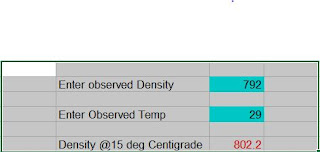Field method – Aniline Solubility method for Aromatics in Naphtha
Field method – Aniline Solubility method for Aromatics in Naphtha
Following properties of Aniline has been used to derive a simple field method to determine Aromatics content in naphtha.
Aromatic hydrocarbons exhibit the lowest, and paraffins the highest values. Cycloparaffins and olefins exhibit values that lie between those for paraffins and aromatics.
The aniline point is useful as an aid in the characterization of pure hydrocarbons and in the analysis of hydrocarbon mixtures.
Aromatic hydrocarbons exhibit the lowest, and paraffins the highest values. Cycloparaffins and olefins exhibit values that lie between those for paraffins and aromatics.
In homologous series the aniline points increase with increasing molecular weight. Although it occasionally is used in combination with other physical properties in correlative methods for hydrocarbon analysis, the aniline point is most often used to provide an estimate of the aromatic hydrocarbon content of mixtures.
Field Method:
1.
Scope:-
1.1
The method is studied for Naphtha Samples
having,
a)
Aromatics = Max 22% Vol
b)
Naphthenes = Max 40% Vol
c)
Olefins = Max 1 % Vol
d)
Paraffins = Balance of 100%
1.2
Boiling range (ASTM D 86) of Naphtha = 30 – 2000C
2
Significance:
2.1 Aniline solubility method indicates the
composition of Naphtha. Lower the Aniline point – Higher
solubility of Naphtha – also suggest higher aromatics or/and naphthenes or
lower paraffins and vice-versa.
3
Summary of the method:
3.1
An appropriate volume of Naphtha sample (see
table 1) and 5 ml of Aniline is taken in conical flask. This mixture is
either cooled or heated slightly and the temperature at which the mixture is
completely soluble is noted. Aromatics is calculated from the empirical
equation given below.
4
Apparatus
and Chemicals:
4.1
Burette (25 or 50 ml capacity)
4.2
Graduated Pipette (10 ml capacity)
4.3
Conical flask (100 ml capacity)
4.4
Aniline point tubes
4.5
Aniline (check purity giving aniline point of
n-heptane 69.3 +/- 0.2 0C as per ASTM D611/IP 2)
5 Procedure:
5.1 Place 5 ml of Aniline in a 100 ml conical flask.
Add appropriate volume of naphtha sample (table 1) from burette to the flask. Keep
a thermometer (IP-39 or IP-64C) to measure temperature of the mixture. Cool or
heat the mixture of flask with swirling,
5.2 Note the miscibility temperature in above step 5.1, similar as the
aniline point method. For the table 1 naphtha sample volume, this temperature
is usually around 27 0C.
5.3
Table 1 for sample size. (see note 4 for Expected Aromatics%).
Expected Aromatic % V
|
Sample size, ml
|
0 - 6
|
70
|
7 - 11
|
50
|
12 - 15
|
40
|
16 - 22
|
20
|
5.4 Determine the aniline point of the sample as
per ASTM D611. If aniline point is more than 600C, do not
use this value and use equation 6.1 for calculation of Aromatics.
6
Calculation:
Calculate the aromatics in
naphtha using one of the following equation:
6.1 Aromatics %V = 24 – 0.29V – 0.5*(T-27)… If Ar%V is less than 6.
6.2 Aromatics %V = 23.5 + A.P. – 0.69V – 1.31*T ..
If Ar%V is between 6 and 15.
6.3 Aromatics
%V = 28.2 + A.P. – 0.89V – 1.23*T .. If Ar%V is more than 15.
Where V = size of the sample
A.P.= Aniline Point as per ASTM D
611
T = miscibility Temperature as per 5.2 above.
7 Precision
:
From
the data generated by us and round robin done, results obtained by this method
is similar to the standard test method of Aromatics - ASTM D1319 Standard Test
Method for Hydrocarbon Types in Liquid Petroleum Products by Fluorescent
Indicator Adsorption.
7.1 Repeatability =
1.0 % V
7.2 Reproducibility =
2.0 % V
Notes :
1 . Heating/cooling process
should be very slow ( max 1 deg C per
minute.
2. Avoid
as far as possible heating/cooling by water bath.
3. Aniline/Naphtha
mixing is an endothermic process.
4. Approx.
aromatics %V for the sample size as per serial number 5.3 can be predicted by
using one of the following empirical equations.
Aromatics % V = 0.55 ( 70 – A.P.) or
Aromatics % V = 225 ( 1.47*D – 1.0) where
A.P. = Aniline point and D =
Density of sample at 15 0C.

Comments